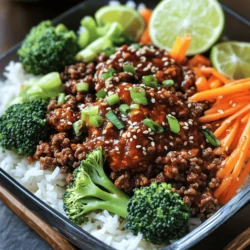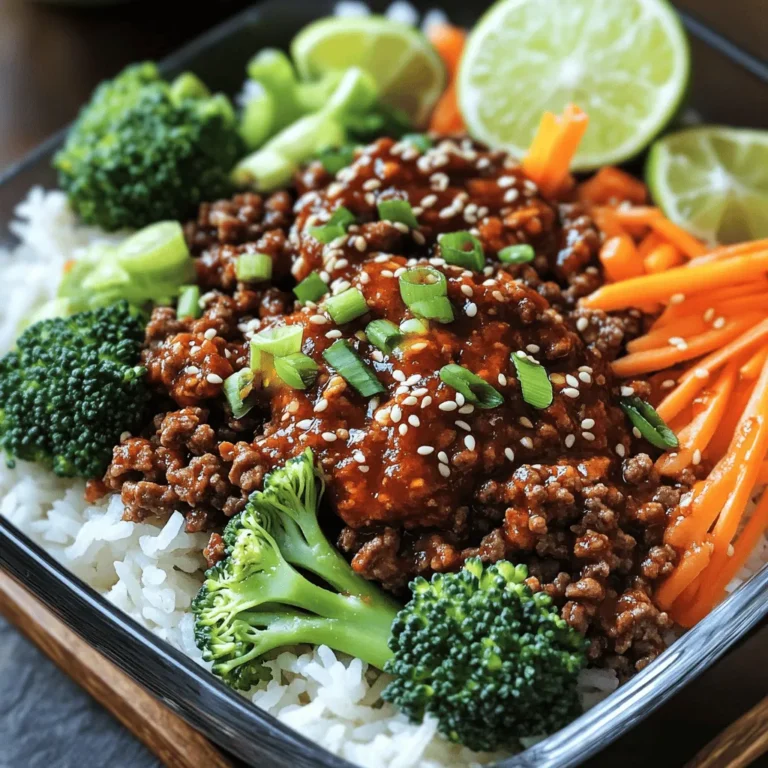Get ready to take your taste buds on a bold journey with Spicy Korean Beef Bowls! This dish is packed with rich flavors and fresh ingredients that will make your meal unforgettable. I’ll guide you through every step, from browning ground beef to creating the perfect sauce with gochujang. Whether you’re a busy parent or a home cook, this recipe is easy and delicious. Let’s dive in and make something amazing together!
Ingredients
Main Ingredients for Spicy Korean Beef Bowls
– 1 lb (450g) ground beef
– 2 tablespoons gochujang (Korean chili paste)
– 2 tablespoons soy sauce
– 1 tablespoon sesame oil
– 2 teaspoons brown sugar
– 1 teaspoon garlic, finely minced
– 1 teaspoon ginger, freshly grated
– 1 cup cooked jasmine rice
– 1 cup broccoli florets, cut into bite-sized pieces
– 1 large carrot, peeled and julienned
– 2 green onions, thinly sliced
The main ingredients make this dish bold and tasty. Ground beef gives a rich flavor. Gochujang and soy sauce add spice and depth. The ginger and garlic boost the taste, making it aromatic. Fresh veggies like broccoli and carrots bring color and crunch.
Optional Garnishes
– Sesame seeds
– Lime wedges
– Green onions
Garnishes make your bowl look great and add fun flavors. Sesame seeds provide a nutty crunch. Lime wedges let you add a zesty kick. Fresh green onions give a burst of freshness on top. Using these garnishes will elevate your Spicy Korean Beef Bowls even more!
Step-by-Step Instructions
Cooking the Beef
Browning Ground Beef
Start by heating a large skillet over medium-high heat. Add 1 lb of ground beef to the skillet. Cook the beef until it turns brown, about 5-7 minutes. Use a spatula to break the meat into smaller pieces as it cooks. This helps it to cook evenly. If you see extra fat, drain it off. You want your dish to be hearty, not greasy.
Adding the Flavor Elements
Once the beef is nicely browned, it’s time to add flavor. Stir in 2 tablespoons of gochujang, 2 tablespoons of soy sauce, and 1 tablespoon of sesame oil. Add 2 teaspoons of brown sugar, 1 teaspoon of minced garlic, and 1 teaspoon of grated ginger. Mix everything well and let it cook for another 3-4 minutes. This helps all the flavors blend together.
Preparing the Vegetables
Steaming Broccoli and Carrots
While the beef cooks, prepare your vegetables. In a pot or steamer, add 1 cup of broccoli florets and 1 large carrot, which you will julienne. Steam them for about 3-5 minutes. You want them tender but still a bit crisp. This adds great texture to the dish.
Timing for Vegetable Tenderness
Keep an eye on the vegetables. You want them cooked but not mushy. They should still have a bright color and a slight crunch. This makes your dish more colorful and enjoyable.
Assembling the Bowls
Layering Rice and Beef
Now, it’s time to put everything together. Start by placing a scoop of cooked jasmine rice at the bottom of each bowl. Top the rice with a generous portion of the spicy beef mixture. The rice will soak up the flavors from the beef, making each bite delightful.
Presentation Techniques
For a beautiful finish, arrange the steamed broccoli and carrots next to the beef. This adds color and makes the dish look fresh. Garnish with sliced green onions and a sprinkle of sesame seeds. Don’t forget to add a lime wedge on the side. Squeezing fresh lime juice over the dish adds a tasty zing just before eating.
Tips & Tricks
Cooking Tips for Perfection
Avoiding Greasiness
To keep your Spicy Korean Beef Bowls light, drain the fat after browning the beef. This step stops the dish from becoming heavy. Use lean ground beef for less grease.
Balancing Flavors
Use gochujang wisely. This spicy paste adds heat but can overpower the dish. Start with two tablespoons and taste as you mix. Adjust with soy sauce and brown sugar for sweetness.
Presentation Advice
Using Eye-Catching Dishware
Choose deep bowls to show off your colorful ingredients. Bright colors from the veggies make the dish pop. The right dishware can make your meal look gourmet.
Enhancing Aroma with Sesame Oil
Drizzle a bit of sesame oil over the finished bowls. This adds a rich aroma that draws people in. The oil also gives a nice shine to your meal.
Serving Suggestions
Complementary Side Dishes
Serve with a light cucumber salad or kimchi. These sides add a refreshing crunch and balance the bold flavors of the beef.
Beverage Pairings
Enjoy your meal with a cold Korean beer or a sweet tea. These drinks pair well and enhance the meal experience.

Variations
Alternative Proteins
You can switch the ground beef with chicken or tofu.
– Chicken: Use ground chicken for a lighter option. Cook it the same way as beef.
– Tofu: For a plant-based choice, use firm tofu. Crumble it like beef and sauté until golden.
If you want vegan substitutes, try seitan or tempeh. They both provide a hearty texture.
Spice Level Adjustments
Want to play with heat? You can adjust the spice level easily.
– How to Modulate Heat: Start with less gochujang. Add more gradually if you want more kick.
– Adding Extra Ingredients for Flavor: Consider adding a splash of rice vinegar. It adds tang without extra heat.
Grain Alternatives
For a healthy twist, swap jasmine rice with other grains.
– Using Brown Rice or Quinoa: Both provide more fiber and nutrients. Cook them according to package directions.
– Cauliflower Rice for Low-Carb: If you want something even lighter, use cauliflower rice. It’s simple to make and absorbs flavors well.
These variations keep the dish fun and fresh. Enjoy experimenting with your Spicy Korean Beef Bowls!
Storage Info
Best Practices for Leftovers
– Refrigerating Prepared Bowls: Store any leftover Spicy Korean Beef Bowls in an airtight container. This method keeps the flavors fresh. Your dish will last in the fridge for up to three days. When you store it, make sure to separate the rice from the beef and veggies. This keeps the rice from becoming soggy.
– Freezing Options: You can freeze the beef mixture for later use. Place the beef in a freezer-safe bag. Remove as much air as possible before sealing. It will maintain its quality for about three months. Broccoli and carrots do not freeze well, so add fresh ones when you reheat.
Reheating Instructions
– Microwave vs. Stovetop: The microwave is quick for reheating. Place your bowl in the microwave for about two minutes. Stir halfway through to heat evenly. The stovetop works too. Heat in a skillet over medium heat, stirring often for about five minutes.
– Preserving Texture and Flavor: To keep the texture nice, add a splash of water when reheating in the microwave. This helps steam the dish. If using the stovetop, a little sesame oil can add flavor back to the beef.
FAQs
What is Gochujang?
Gochujang is a thick, red chili paste from Korea. It combines heat, sweetness, and umami. You will find it made from fermented soybeans, rice, and chili powder. This unique blend makes it a staple in Korean cooking. You can use it in marinades, stews, and sauces.
You can find gochujang in most Asian grocery stores. Look for it in the international aisle of larger supermarkets. It usually comes in a red tub or jar.
Can I Make This Dish in Advance?
Yes, you can prepare this dish ahead of time. It makes meal prep easy and convenient.
For meal prep, cook the beef mixture and store it in the fridge. You can also steam the veggies in advance. Keep the rice separate for the best texture.
For storage, place the components in airtight containers. You can keep them in the fridge for up to three days. For longer storage, freeze the beef mixture and rice.
How Can I Make This Recipe Gluten-Free?
To make this recipe gluten-free, swap the soy sauce. Use tamari or coconut aminos instead. Both work well and provide a similar flavor.
Make sure to check the labels on all ingredients. Some gochujang brands offer gluten-free options. Always choose the ones made without wheat.
This article covered how to make spicy Korean beef bowls. We explored key ingredients, like ground beef and gochujang, and optional garnishes to enhance the dish. The step-by-step guide helped with cooking, preparing veggies, and assembling your bowl attractively. Remember to balance flavors and use eye-catching dishware for a great presentation.
With variations and storage tips, you can enjoy this meal multiple ways. I hope you feel confident to try making this dish and enjoy the flavors it brings to your table.


